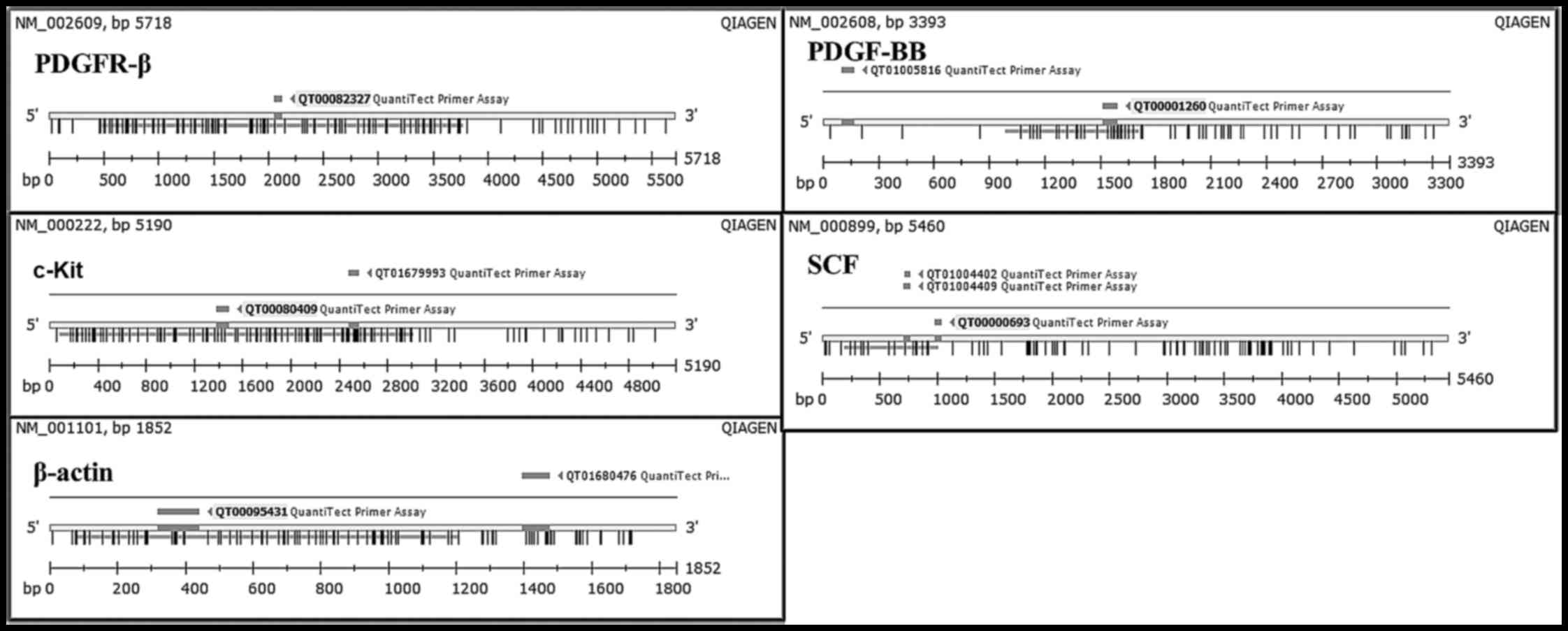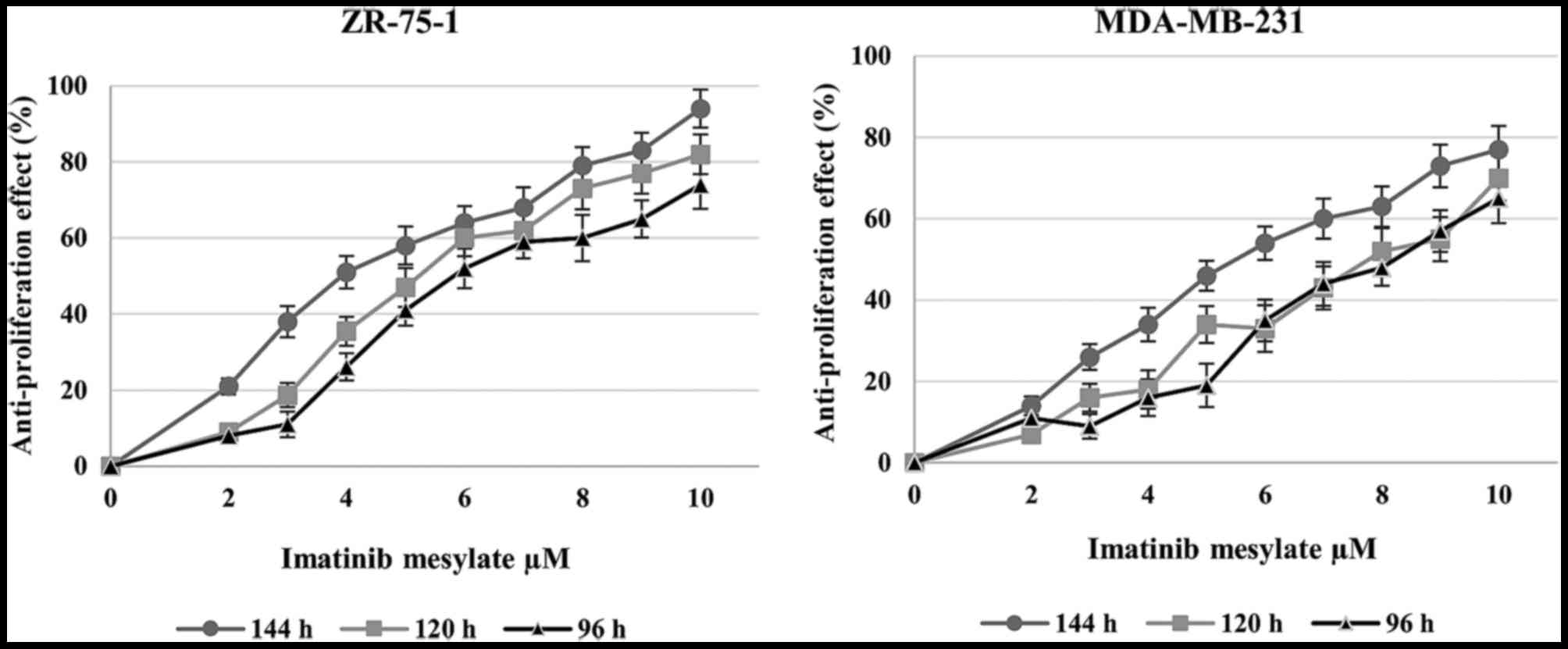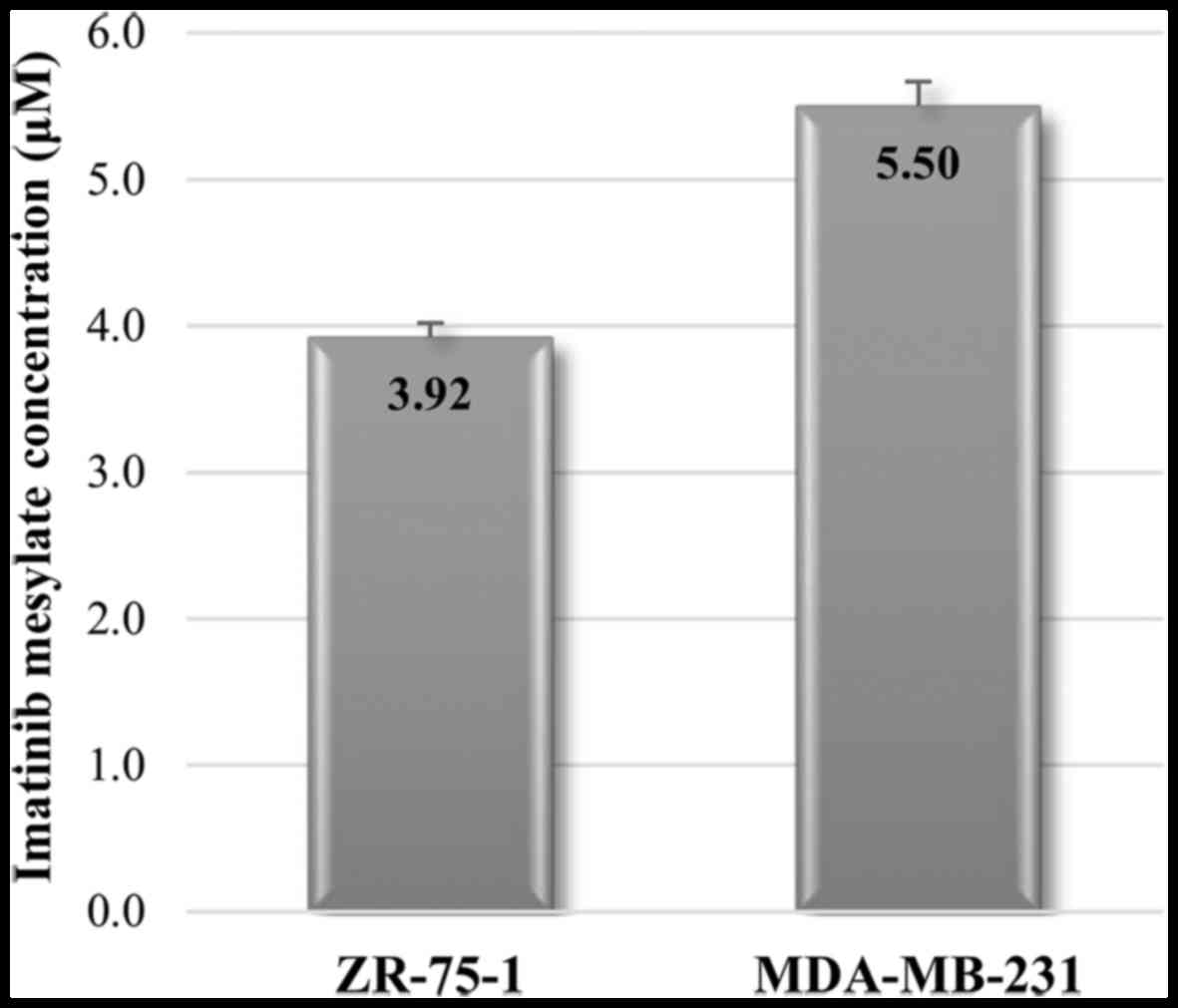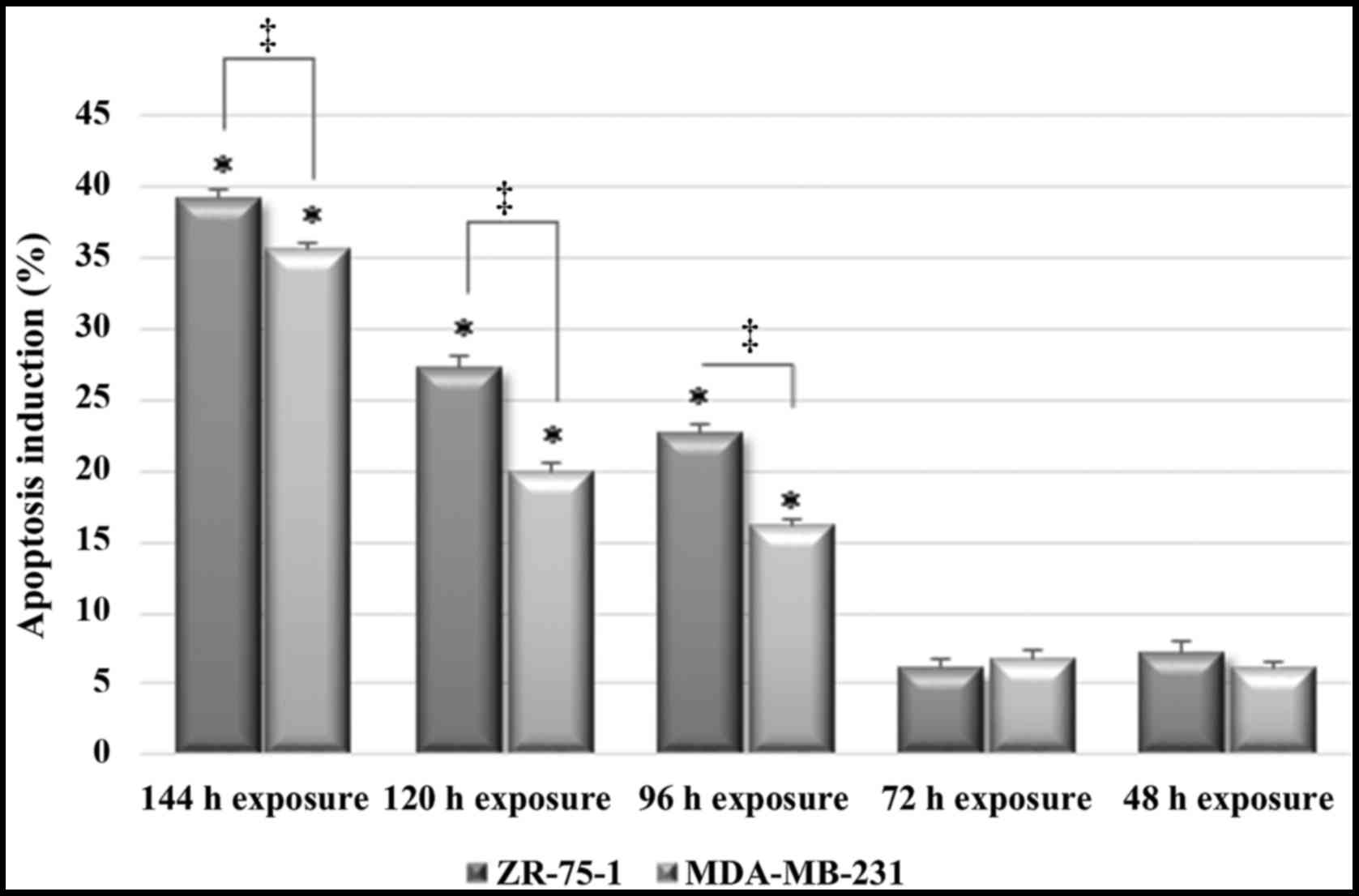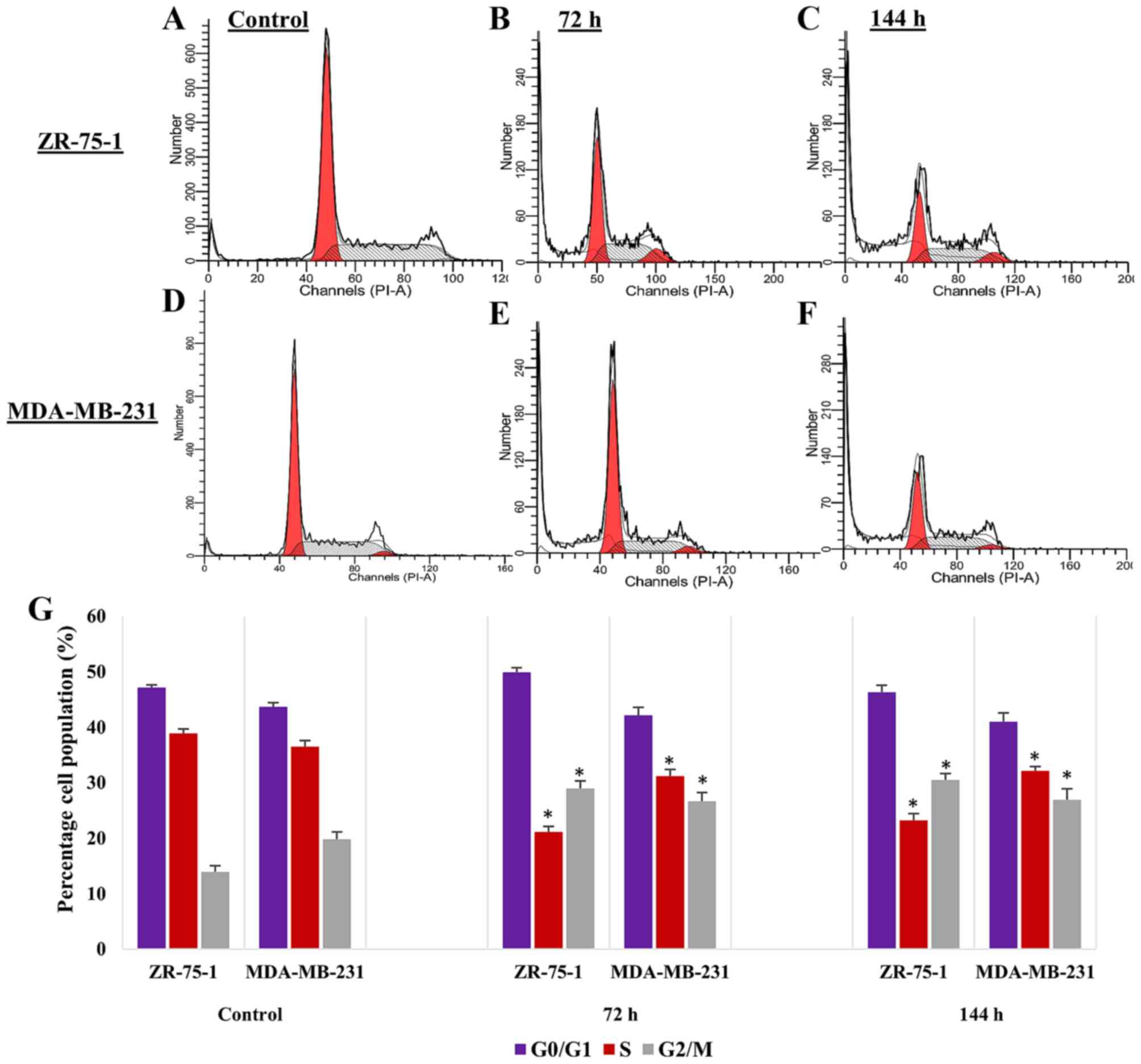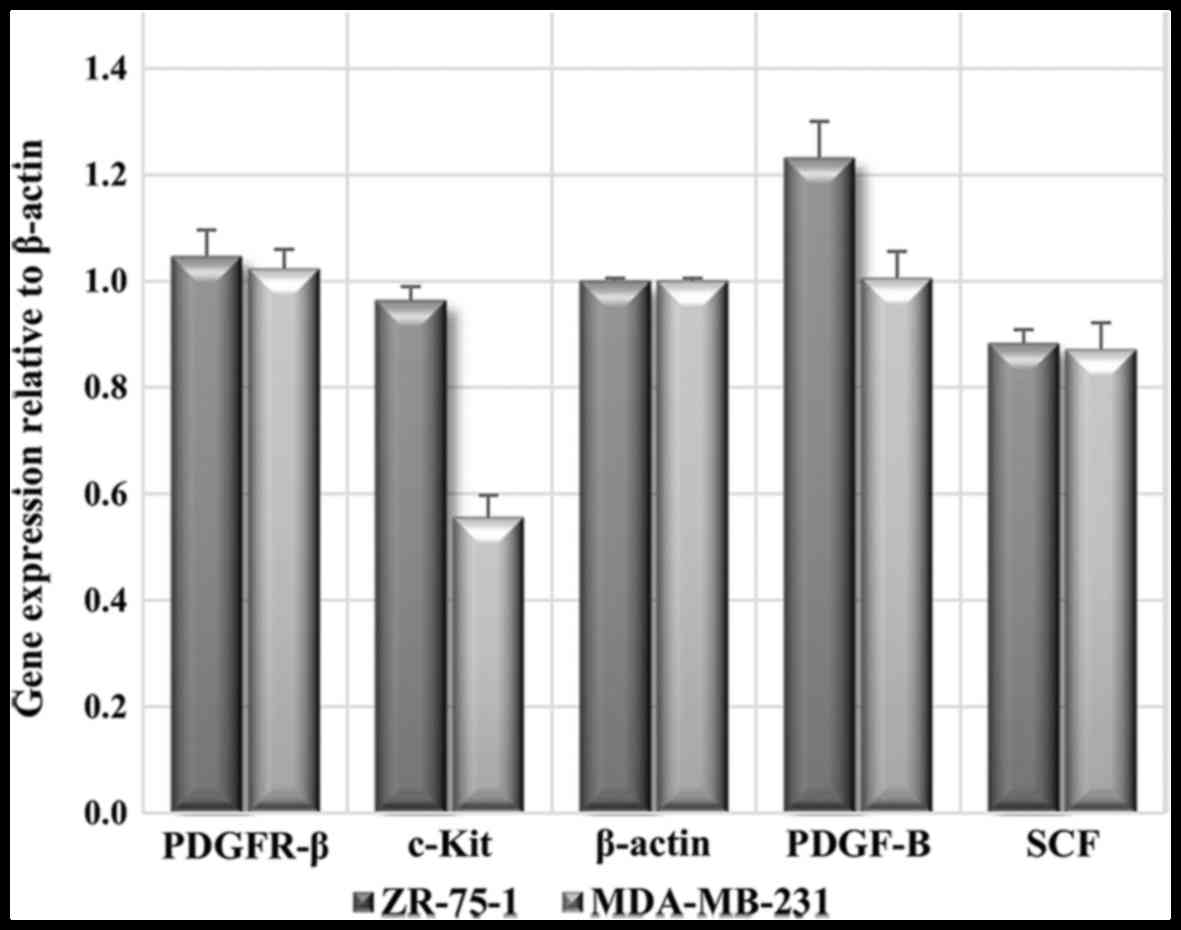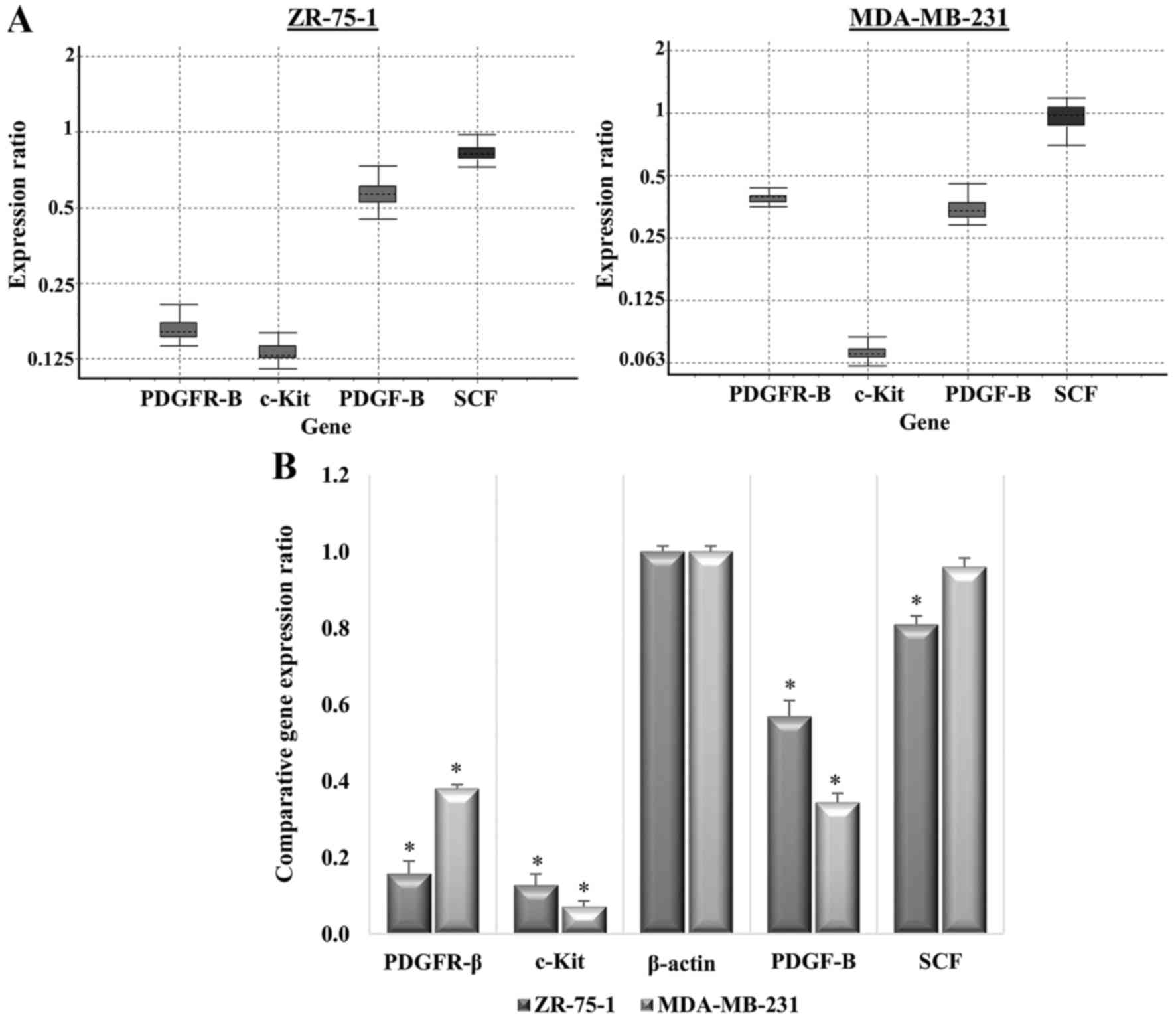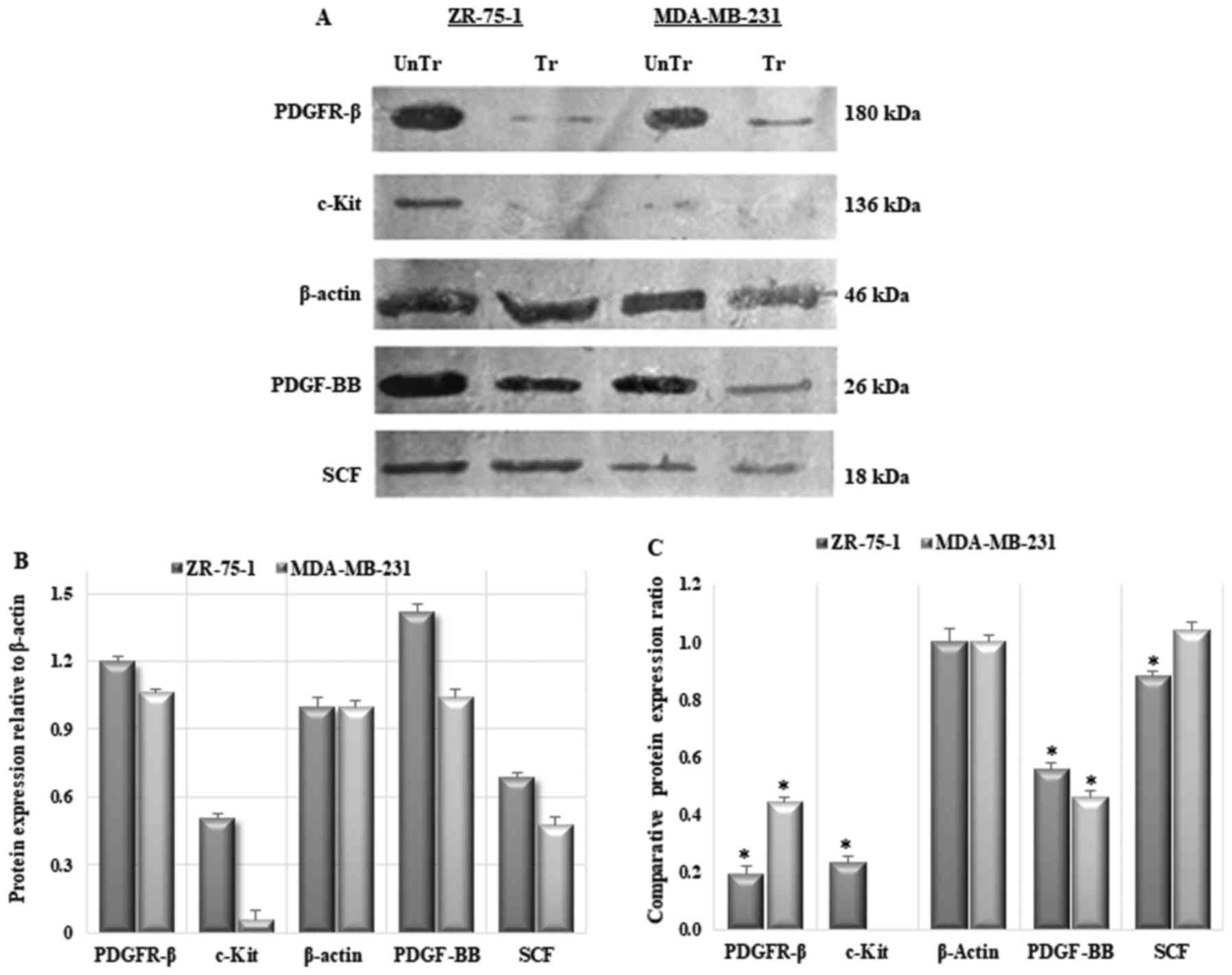Antiproliferative effects of imatinib mesylate on ZR‑75‑1 and MDA‑MB‑231 cell lines via PDGFR‑β, PDGF‑BB, c‑Kit and SCF expression
Corrigendum in: /10.3892/ijmm.2019.4119
- Authors:
- Published online on: March 27, 2018 https://doi.org/10.3892/ijmm.2018.3590
- Pages: 414-424
Abstract
Introduction
Breast cancer is the most prevalent female malignant neoplasm worldwide, the frequency of which has increased in recent years (1). Breast cancer management includes systemic treatments, such as hormone therapy, which suppresses estrogen synthesis or uptake, and chemotherapeutics; as well as topical treatments, including radiotherapy and surgery. Traditional therapeutics that induce inhibition of cell proliferation and DNA replication not only do not possess tumor cell selectivity, but also exert several adverse effects and are associated with inadequate response rates (2,3). Contemporary therapies intend to selectively target cancer cells, in order to improve cancer cure rates and decrease cytotoxicity to normal cells. In breast cancer, these efforts have resulted in the generation of therapies that target aromatase (the P450 enzyme that transforms androgens to estrogens) or estrogen receptors. Recently developed drugs, including letrozole and tamoxifen, exhibit specificity against aromatase and estrogen receptors, respectively; these drugs have produced promising results. However, these drugs are reliant on tumors exhibiting hormone dependency, mainly in estrogen receptor-positive breast cancers (4–6).
One of the main medical developments in the last few decades is cancer chemotherapy. However, these drugs often exhibit limited therapeutic index, and the obtained responses are often unpredictable as well as palliative. Conversely, targeted therapy is focused on cancer-specific signaling pathways and molecules; therefore, it induces less nonspecific toxicities. Tyrosine kinases are important targets, since they have a significant role in the modulation of tumorigenesis and signaling (7–9).
Consequently, novel targeted therapies, which modulate the activity of numerous tyrosine kinase receptors were involved into the therapeutic outlines. Therefore, research has focused on developing novel inhibitory drugs associated with tyrosine kinase receptor pathways. Imatinib mesylate (also known as STI571 or Gleevec) is a targeted, synthetic, oral anti-cancer drug, with a low-molecular weight. Imatinib mesylate is a 2-phenylaminopyridine derivative, which was developed as a selective inhibitor of the BCR-ABL fusion gene product; BCR-ABL is a tyrosine kinase that is contained in a translocation [t(9;22)(q34;q11)] between chromosomes 9 and 22, which is cytogenetically evident as the Philadelphia chromosome (10,11). Imatinib usage in cancers other than those typified by BCR-ABL expression is relevant, due to its biological activity on other type III receptor tyrosine kinases, particularly platelet-derived growth factor (PDGF) and c-Kit [cluster of differentiation (CD)117] receptors, which are functionally and structurally closely connected (12,13). On binding their corresponding ligands, PDGF and stem cell factor (SCF), these receptors serve a significant role in signal transduction that leads to cell survival. Imatinib inhibits signal transduction in a similar manner to its effects on the BCR-ABL transcribed protein, resulting in either selective proliferation inhibition or apoptosis induction. Notably, imatinib has no effect on any other closely-connected non-mutant protein kinase. (14,15).
CD117 is encoded by c-Kit, and is a transmembrane tyrosine kinase receptor that has a significant role in the development of small-cell lung cancer, gastrointestinal stromal tumors, breast cancer and melanoma (16,17).
The expression of PDGFR has been established in malignant breast tissue and adjacent stromal cells, including the pericytes that support blood vessels. Preclinical studies have demonstrated that imatinib exerts antitumor activity in a model of breast carcinoma, particularly in osteolytic bone metastases (18).
Imatinib was initially used to treat chronic myeloid leukemia, resulting in full remission in most patients (19). Furthermore, in solid tumors, imatinib has been reported to exert antiproliferative activity by suppressing tyrosine kinase receptor signaling, including PDGFRs and c-Kit. It is possible to detect receptor expression in numerous types of cancer, including melanoma, meningioma, prostate, ovary, breast and pancreatic cancer (11,20,21).
Blocking the site of intracellular ATP binding can inhibit stimulation of these kinases and the resulting signal transduction. Imatinib can reduce paracrine and autocrine receptor stimulation, as well as the irregular activation of mutated kinases that develops in certain carcinoma cells (22,23). Consequently, imatinib has been used as a chemotherapeutic agent in gastrointestinal stromal tumor therapy, where it deactivates the pathognomonic c-Kit kinase (24). In addition, imatinib inhibits dermatofibrosarcoma protuberans progression, and promotes apoptosis in leukemia and neuroblastoma. In some types of cancer and metastases, incubation with imatinib has been reported to inhibit the aforementioned receptors and suppress cell proliferation (22,25,26). Furthermore, imatinib has been revealed to inhibit the invasiveness of a panel of human epithelial breast cancer cells with various invasive capacities (13).
To evaluate the antiproliferative effects of imatinib mesylate through the gene and protein expression of PDGFR-β and c-Kit, and their corresponding ligands PDGF-BB and SCF, ZR-75-1 and MDA-MB-231 breast cancer cell lines were used. ZR-75-1 and MDA-MB-231 cells comprise human tumorigenic epithelial mammary gland cells; ZR-75-1 cells were derived from ascites of the metastatic site of ductal carcinoma in a 63-year-old female patient, whereas MDA-MB-231 cells were derived from pleural effusion of the metastatic site of adenocarcinoma in a 51-year-old female patient.
The present study aimed to evaluate the in vitro antiproliferative effects of imatinib mesylate on breast carcinoma cell lines, and to investigate whether these effects were accompanied by apoptotic induction or cell cytostatic activity. Furthermore, the gene and protein expression levels of PDGFR-β and c-Kit, and their corresponding ligands PDGF-BB and SCF, were detected in breast cancer cells following treatment with imatinib, in order to investigate its potential targets in breast cancer therapy.
Materials and methods
Materials
Imatinib mesylate was provided by OsvahPharma Co. (Tehran, Iran). RPMI-1640 cell culture medium was supplied by Sigma-Aldrich (Merck KGaA, Darmstadt, Germany). Fetal bovine serum (FBS) was obtained from Gibco (Thermo Fisher Scientific, Inc., Waltham, MA, USA). All other reagents were of analytical grade and deionized water was obtained by reverse osmosis.
Cell culture
The estrogen receptor-positive ZR-75-1 breast carcinoma cell line [American Type Culture Collection (ATCC®) CRL-1500™] and the triple-negative breast carcinoma cell line MDA-MB-231 (ATCC® HTB-26™) were used in the present study. Cell lines were purchased from ATCC (Manassas, VA, USA). Cell lines were cultured at 37°C in an atmosphere containing 5% CO2 in RPMI-1640 medium supplemented with 5% FBS.
Cell treatment
Cells cultured in the aforementioned conditions were harvested from 75 cm2 flasks, rinsed with PBS, and seeded in 96-well plates containing complete cell culture medium at a seeding density of 2,500 cells/well (ZR-75-1) and 1,500 cells/well (MDA-MB-231).
Each treatment group was cultured in triplicate. Following 24 h of culture, adherent cells were incubated in normal medium containing 2, 3, 4, 5, 6, 7, 8, 9 or 10 μM imatinib mesylate for 24, 48, 96, 120 and 144 h at 37°C. Every 48 h, the medium was completely replaced.
Cells were also exposed to 1 mM hydrogen peroxide to ensure minimal viability (positive control), which caused full cell death, as verified by the trypan blue viability staining. For maximal viability, untreated cells which incubated with complete medium without any drug (negative control).
In vitro proliferation assay
Cell lines were cultured and treated as aforementioned, after which the Cell Titer Aqueous One Solution assay (MTS; Promega Corporation, Madison, WI, USA) was conducted according to the manufacturer's protocol, to investigate whether cell proliferation was inhibited.
The half maximal inhibitory concentration (IC50) value of imatinib, which resulted in 50% mortality of viable cells, was measured using the following equation: IC50 = [(50 − A)/(B − A)] x (D − C) + C, where A is the concentration which resulted in <50% mortality; B is the concentration which resulted in ≥50% mortality; C is the concentration of imatinib mesylate that gives A% inhibition, and D is the concentration of imatinib mesylate that gives B% inhibition (27). Subsequently, the IC50 value was used in further experiments. Student's t-test was conducted for statistical analysis and P<0.05 was considered to indicate a statistically significant difference.
Terminal deoxynucleotidyltransferase-mediated dUTP nick end labeling (TUNEL) assay
Fragmentation of oligonucleosomal DNA (a hallmark of apoptosis) was analyzed using the cell death detection ELISA plus kit (Roche Diagnostics GmbH, Mannheim, Germany), to determine whether apoptosis was induced by imatinib mesylate. Briefly, 24-well plates were seeded with 10,000 ZR-75-1 cells/well and 6,000 MDA-MB-231 cells/well.
After 24 h, the cell culture medium was replaced with complete medium containing the corresponding IC50 concentrations of imatinib mesylate. The non-treated control group was cultured in normal medium, whereas the positive control was provided with the kit. Every 48 h, the medium was changed (18). After 48, 72, 96, 120 and 144 h, the assay was conducted according to the manufacturer's protocol, and an ELISA reader was used to obtain spectrophotometric data at 405 nm.
Cell cycle analysis
ZR-75-1 and MDA-MB-231 cell lines were treated with imatinib mesylate in the exponential growth phase for 72 or 144 h. After the incubation, cells were harvested, washed twice with ice-cold PBS and were fixed in 700 μl cold 80% ethanol at 4°C overnight. Subsequently, the cells were washed with cold PBS and suspended in 500 μl ice-cold PBS. Cells were then stained with 200 μl propidium iodide (PI; 50 μg/ml) in the presence of 50 μl RNase A (100 μg/ml) for 40 min at room temperature. RNase A was used to degrade the remaining RNA content, in order to ensure PI bound to the DNA of experimental cell lines only. Cell cycle distribution was analyzed using a flow cytometer (BD FACSCanto II; BD Biosciences, San Jose, CA, USA) and ModFit LT v3.0 software (Verity Software House, Inc., Topsham, ME, USA).
Gene expression analysis
To evaluate the potential alterations in PDGFR-β and c-Kit expression, as well as the expression of their relevant ligands PDGF-B and SCF, in cells treated with imatinib, cell lines were cultured in 6-well plates with RPMI-1640 containing 5% FBS. After 24 h of cell adhesion, the cells were cultured in normal medium containing the corresponding IC50 concentrations of imatinib mesylate for 144 h. The medium was replaced every 48 h; subsequently, total RNA was extracted and gene expression was analyzed.
Receptor expression
In each individual cell line, the expression levels of the tyrosine kinase receptors PDGFR-β and c-Kit, and their relevant ligands PDGF-B and SCF, were detected at the transcriptional level. RNeasy mini kit was used to extract total RNA and RNase-Free DNase (both Qiagen, Inc., Valencia, CA, USA) was used to eliminate genomic DNA. Extracted RNA was stored at −70°C.
Total RNA underwent reverse transcription-polymerase chain reaction (RT-PCR) amplification of nDNA-encoded PDGFR-β, c-Kit, PDGF-B and SCF genes. β-actin was employed as a reference gene for gene expression analysis.
Relative quantification of the transcriptional levels of the genes encoding PDGFR-β, c-Kit, PDGF-B and SCF was conducted using QuantiTect Primer assay kit (Qiagen, Inc., Singapore, Singapore) and RT-PCR SYBR-Green detection according to the One-Step RT-PCR standard protocol. Total RNA (0.1 μg) extracted from treated and untreated breast cancer cell lines underwent One-Step RT-PCR amplifications in 50 μl reactions containing QuantiTect SYBR-Green RT-PCR master mix, QuantiTect Primer assay (Fig. 1), QuantiTect RT Mix and RNase-free water.
Applied Biosystems StepOne Plus Real-Time PCR system (Applied Biosystems; Thermo Fisher Scientific, Inc.) was used for amplification according to the following protocol: Transcriptase was activated for 30 min at 50°C for RT, after which temperature was increased to 95°C for 15 min to activate HotStar Taq DNA Polymerase, inactivate transcriptase and denature the resultant cDNA template. Subsequently, 35 cycles of three-step cycling were conducted, including denaturation at 94°C for 15 sec, annealing for 30 sec at 55°C and extension for 30 sec at 72°C. Finally, amplification was completed with a final extension step at 10 min for 72°C.
Each test was repeated three times in duplicate tubes. To monitor the reagents used in the assay for probable contamination, control tubes without template RNA were incorporated into duplicates, together with the appropriate primer sets in each test. In addition, PCR amplification was conducted on negative control tubes without template RNA. The efficiency of the four primer pairs was evaluated. Amplification cycle was determined using StepOne Software v2.3 (Applied Biosystems; Thermo Fisher Scientific, Inc.), in which product buildup was beyond the threshold (Cq). RT-qPCR Cq values were analyzed using standard REST 2009 software, which is a standalone software tool developed by Qiagen and M. Pfaffl (Technical University Munich, Munich, Germany) for gene expression data analysis (28). In order to confirm the reliability of the results in each experiment, the mean Cq of each sample for a given gene in each experiment (repeated four times) was normalized to the mean Cq value of the reference gene in untreated and treated cell lines, which was employed as control (β-actin).
Relative gene expression in untreated groups was calculated according to the following equation : Relative gene expression = 1/(Cq / Cq Hk), where Cq is the average Cq value of the genes of interest in untreated cell lines and Cq Hk is the average Cq value of β-actin (29).
Western blot analysis
To determine the effects of imatinib mesylate on the protein expression levels of PDGFR-β, c-Kit, and their corresponding ligands PDGF-BB and SCF, cells were seeded in 12-well plates and were treated with the corresponding IC50 concentrations of imatinib mesylate for 144 h. Cell lysis buffer [120 mM NaCl, 50 mM Tris-HCl (pH 8.0), 1 mM phenylmethylsulfonyl fluoride and 0.5% NP-40) was used to extract total cell proteins. Subsequently, 40 μg proteins which were quantified by nano-drop instrument, were separated by 10% SDS-PAGE, and proteins were then transferred to a polyvinylidene difluoride (PVDF) membranes (Bio-Rad Laboratories, Inc., Hercules, CA, USA). The membranes were blocked with 5% nonfat milk in TBS-Tween-20 buffer 7 (1.5 M NaCl, 0.12 M Tris-base, 0.1% Tween-20) at room temperature for 1 h, after which they were incubated with the relevant primary antibodies at 4°C overnight. Subsequently, the membranes were incubated with alkaline phosphatase-conjugated secondary antibody at room temperature for 45 min. The following primary antibodies: Anti-PDGFR-β (P-20) (sc-339), anti-c-Kit (Ab 81) (sc-13508), anti-β-actin (C4) (sc-47778), anti-PDGF-BB (H-55) (sc-7878) and anti-SCF (G-19) (sc-1303), were purchased from Santa Cruz Biotechnology, Inc. (Dallas, TX, USA) The PVDF membranes were incubated for 45 min with alkaline phosphatase-conjugated anti-mouse/anti-rabbit or anti-goat (1:5,000) secondary antibodies and were then washed twice with TBST. The blots were developed using BCIP/NBT colorimetric detection (Santa Cruz Biotechnology, Inc.), in order to semi-quantify target protein bands using ImageJ 1.47v software.
Statistical analysis
To determine the significance between treated and untreated control groups, ANOVA was performed. Statistical analysis was conducted using the REST 2009 software, which is a standalone software tool, established by M. Pfaffl (Technical University Munich) and Qiagen, Inc. (28), for analysis of comparative-quantitative gene expression data, and Microsoft Office Excel 2013 (Microsoft Corporation, Redmond, WA, USA). P<0.05 was considered to indicate a statistically significant difference.
Results
Imatinib suppresses late, but not early, proliferation of breast cancer cells
To evaluate the antiproliferative and cytotoxic effects of imatinib mesylate on breast cancer cell lines, an MTS cell proliferation assay was conducted. Both cell lines were treated for 96, 120 and 144 h with 2–10 μM clinically relevant imatinib mesylate concentrations (30) in the presence of FBS-containing medium. As shown in Fig. 3, imatinib mesylate revealed a significant dose-dependent effect on MDA-MB-231 and ZR-75-1 breast carcinoma cancer cell lines. No significant effect was detected in cells treated with imatinib for 48 and 96 h; however, in ZR-75-1 cells, 144 h treatment with <6 μM imatinib mesylate resulted in a significant increase in proliferation inhibition. However, 96 and 120 h treatment with higher concentrations of imatinib mesylate (>6 μM) did not exert time-dependent antiproliferative effects.
The average IC50 values of imatinib mesylate were determined 144 h after treatment, as follows: 5.5 μM for MDA-MB-231 and 3.92 μM for ZR-75-1 (Fig. 2).
The results of the present study revealed that 144 h treatment had the most significant toxic effect on both breast cancer cell lines. Therefore, 144 h exposure time was selected for further experiments.
Apoptosis is induced with long-term imatinib treatment
The apoptotic effects of imatinib mesylate on breast cancer cell lines were determined using the quantitative TUNEL assay, which detects DNA breakage as a hallmark of late apoptosis. After 96 h, treatment of each cell line with the relevant IC50 value of imatinib mesylate resulted in a significant increase in the number of apoptotic cells compared with in the untreated group. In the present study, 144 h of exposure was selected for further study in order to determine the inhibitory effects of imatinib on the two cell lines.
As demonstrated in Fig. 4, the highest percentage of apoptotic cells (39.2%) was detected in the ZR-75-1 group after 144 h, whereas the percentage of apoptotic MDA-MB-231 cells was 35.6% at 144 h, which was slightly lower than the percentage of apoptotic ZR-75-1 cells. However, treatment with imatinib for 120 and 96 h resulted in a significant difference in apoptotic index between MDA-MB-231 and ZR-75-1 cells, this may be due to the inhibitory mechanism of action of imatinib mesylate. Therefore, the results of a TUNEL assay indicated that the ZR-75-1 cell line was more sensitive to imatinib mesylate-induced apoptosis compared with the MDA-MB-231 cell line. Apoptotic induction was confirmed in the positive control group, which was provided by the Cell Death Detection ELISA plus kit (Roche Diagnostics; data not shown).
Imatinib induces cell cycle arrest at G2/M phase
The present study indicated that, in breast carcinoma cell lines, imatinib mesylate treatment significantly suppressed cell proliferation after 96 h; however, the antiproliferative effects of imatinib mesylate treatment after 72 h were previously confirmed by Weigel et al (18) in a panel of breast cancer cell lines. Furthermore, in the present study, after 72 h of treatment, apoptosis was not significantly induced by imatinib. Conversely, after 96 h of treatment, apoptosis was significantly induced in the breast cancer cell lines. Subsequently, a cell cycle analysis was conducted to determine the effects of imatinib mesylate on cell cycle progression in ZR-75-1 and MDA-MB-231 cell lines (Fig. 5). Similar to the results of the proliferation assay, the cell cycle analysis in breast carcinoma cell lines revealed that imatinib suppressed carcinoma cell proliferation, as indicated by a significant increase in cells in G2/M phase and a significant decrease in cells in S phase. Furthermore, the results indicated that suppression of cell proliferation after 72 h of treatment was due only to cell cytostatic activity; however, after 144 h, induction of apoptosis, as well as cell cytostatic activity, was responsible for the antiproliferative effects of imatinib mesylate on ZR-75-1 and MDA-MB-231 breast carcinoma cell lines.
PDGFR-β, c-Kit, PDGF-BB and SCF gene expression in breast cancer cell lines
The expression levels of genes encoding PDGFR-β, c-Kit, and their corresponding ligands PDGF-B and SCF, in breast carcinoma cell lines were investigated using RT-qPCR. The β-actin housekeeping gene was used to normalize the relative expression levels of genes of interest.
The results of RT-qPCR are presented in Fig. 6 and revealed that the four genes of interest were expressed in both carcinoma cell lines with variable expression levels. The mRNA expression levels of PDGFR-β were expressed in both carcinoma cell lines at similar levels. Similar to the levels of its corresponding receptor, PDGF-B mRNA exhibited high expression in both carcinoma cell lines; however, higher expression was detected in the ZR-75-1 cell line. c-Kit expression was significantly less in MDA-MB-231 cells compared to ZR-75-1, whereas the expression of its complementary ligand, SCF, was equally expressed in both cancer cell lines. These findings indicated that the breast carcinoma cell lines express at least two potential targets for imatinib. Furthermore, protein expression levels were confirmed by western blotting.
Imatinib affects PDGFR-β/PDGF-B and c-Kit/SCF gene expression
The relative quantification method was used for gene expression analysis. Gene expression of treated samples was compared with the untreated control group, and was normalized to the endogenous control (housekeeping gene) using REST 2009 software. Following treatment of each cell line with the specific IC50 value of imatinib, the expression levels of PDGFR-β, PDGF-B and c-Kit were significantly downregulated compared with in the untreated group (P<0.05), whereas SCF was significantly but slightly downregulated in the ZR-75-1 cell line, but was not significantly altered in the MDA-MB-231 cell line.
According to relative gene expression analysis, as presented in Fig. 7 and Table I, the ZR-75-1 cell line exhibited reduced suppression with regards to expression levels compared with the MDA-MB-231 cell line. Results of the PDGF-β gene expression analysis revealed that, similar to its corresponding receptor, its expression was relatively downregulated in the imatinib-treated group compared with in the untreated control group; relative expression levels were lower in the MDA-MB-231 cell line (mean mRNA expression level, 0.34) compared with in the ZR-75-1 cell line (mean mRNA expression level, 0.57). In addition, c-Kit was markedly downregulated in MDA-MB-231 and ZR-75-1 cell lines (mean mRNA expression levels, 0.07 and 0.13, respectively), whereas the complementary ligand SCF was not significantly altered in the MDA-MB-231 cell line, and was insignificantly downregulated in ZR-75-1 cells (mean mRNA expression level, 0.82).
PDGFR-β/PDGF-BB and c-Kit/SCF protein expression is also affected by imatinib
To evaluate the expression and regulation of genes and proteins of interest under imatinib mesylate treatment, RT-qPCR and western blotting were conducted. In order to confirm the results of the gene expression study, post-transcriptional regulation was analyzed using western blotting.
Western blot images were semi-quantified three times using ImageJ 1.47v software (National Institutes of Health, Bethesda, MD, USA), and mean results were considered relative protein expression levels. The relative expression levels of examined proteins in untreated carcinoma cell lines are presented in Fig. 8. The results revealed that PDGFR-β protein was highly expressed in both examined breast carcinoma cell lines. Similar to its corresponding receptor, the protein expression levels of PDGF-BB were expressed in both cell lines, with markedly higher expression in ZR-75-1 cell line. c-Kit protein expression, as an imatinib mesylate target, was markedly lower than PDGFR-β, with the lowest expression in the MDA-MB-231 cell line; however, SCF protein was moderately expressed in both carcinoma cell lines.
Western blot analysis demonstrated that PDGFR-β, c-Kit and PDGF-BB protein expression was significantly downregulated in cells treated with the corresponding IC50 values of imatinib mesylate compared with in the untreated control cells, with β-actin as internal control.
As shown in Fig. 8, the protein expression levels of PDGFR-β were significantly suppressed (P<0.05) in both treated cell lines compared with in the untreated control cells; expression was strongly suppressed in the ZR-75-1 cell line (mean protein expression level, 0.19) and was also suppressed in MDA-MB-231 cells (protein expression, 0.44). Relative expression levels of PDGF-BB were significantly suppressed in ZR-75-1 and MDA-MB-231 cell lines (mean protein expression levels, 0.56 and 0.46, respectively). The protein expression levels of c-Kit were markedly reduced in ZR-75-1 cells (mean protein expression level, 0.24), whereas c-Kit protein expression was very low in untreated cells, and was completely suppressed and undetectable in treated MDA-MB-231 cells. Furthermore, the complementary ligand SCF did not exhibit any significant alterations in protein expression in imatinib mesylate-treated MDA-MB-231 cells, whereas SCF protein expression was downregulated in the ZR-75-1 cell line (mean protein expression level, 0.88).
Discussion
Imatinib mesylate is a molecularly-specific anticancer agent, which targets the tyrosine kinase receptors PDGFRs and c-Kit (22). According to the findings of the present study, imatinib mesylate treatment induced apoptosis of breast carcinoma cells, particularly after 96 h, which may be attributed to the regulation of PDGFR and c-Kit pathways. The incubation time required to induce apoptosis of other cell types varies. For example, neuroblastoma cells exhibit signs of apoptosis after 48 h of incubation, whereas osteosarcoma cells undergo apoptosis after 120 h (31,32). The proapoptotic effects of imatinib have been reported in breast cancer cells in the present study, as well as in other types of cancer cells in previous studies; however, imatinib does not induce apoptosis at all time points. For example, in a previous study, in ovarian carcinoma cells, imatinib exerted G1/G0 cytostatic activity (21). In addition, apoptosis among vascular endothelial cells is not directly related to imatinib treatment and might be the consequence of other factors (21). Furthermore, Uziel et al (33) reported the cytostatic activity of imatinib in Ewing sarcoma cells in G2/M phase. The results of the present study detected a significant G2/M phase cell cycle arrest, and a significant reduction in the number of cells at S phase, in breast carcinoma cell lines under imatinib mesylate treatment, and the antiproliferative effects of imatinib were detected, which was concordant with the findings of Malavaki et al (13). Furthermore, the IC50 values of imatinib can reach between 4 and 6 μM in human blood serum in vivo (34). Therefore, the in-vitro IC50 of imatinib mesylate against MDA-MB-231 and ZR-75-1 which was calculated in this study can be availed in blood.
Numerous diseases, including cancer, cardiovascular diseases and developmental defects, have been reported to be associated with the abnormal regulation of cytokines or growth factors, and corresponding receptors. It is well known that breast carcinoma tissues express PDGF and some types of carcinoma express c-Kit. c-Kit and PDGFR availability in target cells is important for cellular reactions dependent on cytokines/PDGF, and is reliant on their regulation (35–37). The present study examined the expression of the mature forms of PDGFR-β and c-Kit, as well as their corresponding ligands PDGF-BB and SCF, in breast cancer cell lines.
The PDGF-BB complementary ligand of PDGFR-β was markedly expressed in both studied cell lines. Furthermore, the receptor tyrosine kinase c-Kit, and its complementary ligand SCF, were expressed by both cell lines, and therefore may be considered additional targets for imatinib mesylate treatment. These findings indicated that at least two potential targets for imatinib were expressed by the studied breast carcinoma cell lines.
PDGF protein expression, as a ligand for PDGFRs, was detected in both studied breast carcinoma cell lines. It has been suggested that the paracrine and autocrine effects of PDGF-BB on stimulation of the PDGFR-β signaling pathway are essential for tumor angiogenesis and cell proliferation of breast cancer (38); this has also been observed in other malignancies, including glioblastoma and ovarian cancer (39,40). The present study suggested that imatinib may inhibit proliferation of breast cancer cell lines by exerting effects on this pathway.
Treatment with imatinib led to reduced gene and protein expression of PDGFR-β in both examined breast cancer cell lines, as determined by RT-qPCR. This outcome has also been reported in neuroblastoma cells, osteosarcoma, ovarian cancer and bone endothelial cells. In addition, it has been reported that autocrine PDGFR signaling may stimulate metastasis of breast cancer. In a mouse model, this could be prevented by imatinib treatment and overexpression of the dominant-negative form of PDGFR (41–43).
Notably, in both cell lines used in the present study, treatment with imatinib mesylate resulted in transcriptional and post-transcriptional downregulation of PDGFR-β and c-Kit receptors. Alterations in ligand expression were also analyzed. It is usually presumed that ligand expression increases due to receptor inhibition. However, receptor inhibition may have an effect on the downstream kinase cascade pathway in paracrine signaling, and particularly in autocrine signaling, thus modulating ligand expression. Results of the gene and protein expression analyses established PDGF-BB as an autocrine/paracrine ligand that was downregulated in response to imatinib in both cell lines. However, imatinib treatment did not significantly downregulate SCF expression, which may be attributed to endocrine signaling of this cytokine.
The present results confirmed that imatinib mesylate not only suppressed tyrosine kinase receptor expression, but also affected the expression of the receptor tyrosine kinase ligand, PDGF, which may lead to tumor suppression. However, imatinib could not control the expression of SCF.
Comparison between the sensitivities of ZR-75-1 cells, which expressed PDGFR-β and c-Kit, and MDA-MB-231 cells, which possessed low c-Kit expression, to imatinib mesylate treatment verified that PDGFR-β and c-Kit are targets of imatinib mesylate inhibition. In addition, suppression of PDGFR-β and c-Kit expression via imatinib mesylate may lead to increased inhibition and anticancer effects.
In conclusion, the present study revealed that imatinib mesylate-induced modulation of PDGFR-β, c-Kit and PDGF-BB may result in cell death and growth suppression of breast cancer cell lines via apoptosis or cell cycle arrest. Furthermore, imatinib mesylate targets the PDGFR-β and c-Kit signaling pathways via its effects on downstream kinase cascade regulation, consequently resulting in expression modulation whenever the receptor inhibition result in the gene or protein expression, it confirm the downstream regulation. Therefore, the present study suggested that PDGFR-β and c-Kit expression may be able to predict the effectiveness of imatinib and monitor its potential therapeutic effects in patients with breast cancer. Consequently, imatinib mesylate may be considered a promising medication for the treatment of breast cancer.
Abbreviations:
|
PDGF |
platelet-derived growth factor |
|
SCF |
stem cell factor |
|
FBS |
fetal bovine serum |
|
RT-PCR |
reverse transcription-polymerase chain reaction |
Acknowledgments
The present study was supported by the University of Malaya IPPP research grant (grant no. PV047/2011A). The funders had no role in study design, data collection and analysis, decision to publish, or preparation of the manuscript. The authors of the present study would like to thank OsvahPharma Co. (Tehran, Iran) for their gift of imatinib mesylate, and the Department of Pharmaceutics, Faculty of Pharmacy, Tehran University of Medical Sciences and the Professor Alborzi Clinical Microbiology Research Center (PACMRC) for providing and supporting the use of technical equipment.
References
|
Stewart B and Wild CP: World Cancer Report 2014. WORLD. 2015. | |
|
Coates AS, Winer EP, Goldhirsch A, Gelber RD, Gnant M, Piccart-Gebhart M, Thürlimann B and Senn HJ; Panel Members: Tailoring therapies--improving the management of early breast cancer: St Gallen International Expert Consensus on the Primary Therapy of Early Breast Cancer 2015. Ann Oncol. 26:1533–1546. 2015. View Article : Google Scholar : PubMed/NCBI | |
|
Lopez L, Carvajal C, Gallardo M and Russo N: Evolution in breast cancer suspicion and extent of surgery at a radio-oncology center. Rev Chil Cir. 66:241–244. 2014. | |
|
Ross JS, Fletcher JA, Bloom KJ, Linette GP, Stec J, Symmans WF, Pusztai L and Hortobagyi GN: Targeted therapy in breast cancer: The HER-2/neu gene and protein. Mol Cell Proteomics. 3:379–398. 2004. View Article : Google Scholar : PubMed/NCBI | |
|
Ellis MJ, Coop A, Singh B, Mauriac L, Llombert-Cussac A, Jänicke F, Miller WR, Evans DB, Dugan M, Brady C, et al: Letrozole is more effective neoadjuvant endocrine therapy than tamoxifen for ErbB-1- and/or ErbB-2-positive, estrogen receptor-positive primary breast cancer: Evidence from a phase III randomized trial. J Clin Oncol. 19:3808–3816. 2001. View Article : Google Scholar : PubMed/NCBI | |
|
Jordan VC: Tamoxifen (ICI46,474) as a targeted therapy to treat and prevent breast cancer. Br J Pharmacol. 147(Suppl 1): S269–S276. 2006. View Article : Google Scholar : PubMed/NCBI | |
|
Gschwind A, Fischer OM and Ullrich A: The discovery of receptor tyrosine kinases: Targets for cancer therapy. Nat Rev Cancer. 4:361–370. 2004. View Article : Google Scholar : PubMed/NCBI | |
|
LaVallee TM, Alvarado D, Garton AJ, Trombetta ES, Gedrich R and McMahon G: Emerging receptor tyrosine kinase drug targets: Implications for antibody-based therapies for oncology and immunologic disorders. Crit Rev Oncog. 20:485–508. 2015. View Article : Google Scholar : PubMed/NCBI | |
|
Kadivar A, Kamalidehghan B, Javar HA, Davoudi ET, Zaharuddin ND, Sabeti B, Chung LY and Noordin MI: Formulation and in vitro, in vivo evaluation of effervescent floating sustained-release imatinib mesylate tablet. PLoS One. 10:e01268742015. View Article : Google Scholar : PubMed/NCBI | |
|
Manley PW, Cowan-Jacob SW, Buchdunger E, Fabbro D, Fendrich G, Furet P, Meyer T and Zimmermann J: Imatinib: A selective tyrosine kinase inhibitor. Eur J Cancer. 38(Suppl 5): S19–S27. 2002. View Article : Google Scholar | |
|
Radford IR: Imatinib. Novartis Curr Opin Investig Drugs. 3:492–499. 2002. | |
|
Buchdunger E, Cioffi CL, Law N, Stover D, Ohno-Jones S, Druker BJ and Lydon NB: Abl protein-tyrosine kinase inhibitor STI571 inhibits in vitro signal transduction mediated by c-kit and platelet-derived growth factor receptors. J Pharmacol Exp Ther. 295:139–145. 2000.PubMed/NCBI | |
|
Malavaki CJ, Roussidis AE, Gialeli C, Kletsas D, Tsegenidis T, Theocharis AD, Tzanakakis GN and Karamanos NK: Imatinib as a key inhibitor of the platelet-derived growth factor receptor mediated expression of cell surface heparan sulfate proteoglycans and functional properties of breast cancer cells. FEBS J. 280:2477–2489. 2013. View Article : Google Scholar : PubMed/NCBI | |
|
Dong Y, Han Q, Zou Y, Deng Z, Lu X, Wang X, Zhang W, Jin H, Su J, Jiang T, et al: Long-term exposure to imatinib reduced cancer stem cell ability through induction of cell differentiation via activation of MAPK signaling in glioblastoma cells. Mol Cell Biochem. 370:89–102. 2012. View Article : Google Scholar : PubMed/NCBI | |
|
Verweij J, van Oosterom A, Blay J-Y, Judson I, Rodenhuis S, van der Graaf W, Radford J, Le Cesne A, Hogendoorn PC, di Paola ED, et al: Imatinib mesylate (STI-571 Glivec, Gleevec) is an active agent for gastrointestinal stromal tumours, but does not yield responses in other soft-tissue sarcomas that are unselected for a molecular target. Results from an EORTC Soft Tissue and Bone Sarcoma Group phase II study. Eur J Cancer. 39:2006–2011. 2003. View Article : Google Scholar : PubMed/NCBI | |
|
Paschka P, Marcucci G, Ruppert AS, Mrózek K, Chen H, Kittles RA, Vukosavljevic T, Perrotti D, Vardiman JW, Carroll AJ, et al Cancer and Leukemia Group B: Adverse prognostic significance of KIT mutations in adult acute myeloid leukemia with inv(16) and t(8;21): A Cancer and Leukemia Group B Study. J Clin Oncol. 24:3904–3911. 2006. View Article : Google Scholar : PubMed/NCBI | |
|
Heinrich MC, Griffith DJ, Druker BJ, Wait CL, Ott KA and Zigler AJ: Inhibition of c-kit receptor tyrosine kinase activity by STI 571, a selective tyrosine kinase inhibitor. Blood. 96:925–932. 2000.PubMed/NCBI | |
|
Weigel MT, Meinhold-Heerlein I, Bauerschlag DO, Schem C, Bauer M, Jonat W, Maass N and Mundhenke C: Combination of imatinib and vinorelbine enhances cell growth inhibition in breast cancer cells via PDGFR β signalling. Cancer Lett. 273:70–79. 2009. View Article : Google Scholar | |
|
Demetri GD, von Mehren M, Blanke CD, Van den Abbeele AD, Eisenberg B, Roberts PJ, Heinrich MC, Tuveson DA, Singer S, Janicek M, et al: Efficacy and safety of imatinib mesylate in advanced gastrointestinal stromal tumors. N Engl J Med. 347:472–480. 2002. View Article : Google Scholar : PubMed/NCBI | |
|
Bond M, Bernstein ML, Pappo A, Schultz KR, Krailo M, Blaney SM and Adamson PC: A phase II study of imatinib mesylate in children with refractory or relapsed solid tumors: A Children's Oncology Group study. Pediatr Blood Cancer. 50:254–258. 2008. View Article : Google Scholar | |
|
Matei D, Chang DD and Jeng M-H: Imatinib mesylate (Gleevec) inhibits ovarian cancer cell growth through a mechanism dependent on platelet-derived growth factor receptor α and Akt inactivation. Clin Cancer Res. 10:681–690. 2004. View Article : Google Scholar | |
|
Gross DJ, Munter G, Bitan M, Siegal T, Gabizon A, Weitzen R, Merimsky O, Ackerstein A, Salmon A, Sella A, et al Israel Glivec in Solid Tumors Study Group: The role of imatinib mesylate (Glivec) for treatment of patients with malignant endocrine tumors positive for c-kit or PDGF-R. Endocr Relat Cancer. 13:535–540. 2006. View Article : Google Scholar : PubMed/NCBI | |
|
de Jong JS, van Diest PJ, van der Valk P and Baak JP: Expression of growth factors, growth inhibiting factors, and their receptors in invasive breast cancer. I: An inventory in search of autocrine and paracrine loops. J Pathol. 184:44–52. 1998. View Article : Google Scholar : PubMed/NCBI | |
|
Lopes LF and Bacchi CE: Imatinib treatment for gastrointestinal stromal tumour (GIST). J Cell Mol Med. 14:42–50. 2010. View Article : Google Scholar | |
|
Kim KB, Eton O, Davis DW, Frazier ML, McConkey DJ, Diwan AH, Papadopoulos NE, Bedikian AY, Camacho LH, Ross MI, et al: Phase II trial of imatinib mesylate in patients with metastatic melanoma. Br J Cancer. 99:734–740. 2008. View Article : Google Scholar : PubMed/NCBI | |
|
Rutkowski P, Van Glabbeke M, Rankin CJ, Ruka W, Rubin BP, Debiec-Rychter M, Lazar A, Gelderblom H, Sciot R, Lopez-Terrada D, et al European Organisation for Research and Treatment of Cancer Soft Tissue/Bone Sarcoma Group; Southwest Oncology Group: Imatinib mesylate in advanced dermatofibrosarcoma protuberans: Pooled analysis of two phase II clinical trials. J Clin Oncol. 28:1772–1779. 2010. View Article : Google Scholar : PubMed/NCBI | |
|
Mahata S, Maru S, Shukla S, Pandey A, Mugesh G, Das BC and Bharti AC: Anticancer property of Bryophyllum pinnata (Lam.) Oken leaf on human cervical cancer cells. BMC Complement Altern Med. 12:152012. View Article : Google Scholar | |
|
Pfaffl MW, Horgan GW and Dempfle L: Relative expression software tool (REST) for group-wise comparison and statistical analysis of relative expression results in real-time PCR. Nucleic Acids Res. 30:e362002. View Article : Google Scholar : PubMed/NCBI | |
|
Livak KJ and Schmittgen TD: Analysis of relative gene expression data using real-time quantitative PCR and the 2(-Delta Delta C(T)) Method. Methods. 25:402–408. 2001. View Article : Google Scholar | |
|
Hu S, Franke RM, Filipski KK, Hu C, Orwick SJ, de Bruijn EA, Burger H, Baker SD and Sparreboom A: Interaction of imatinib with human organic ion carriers. Clin Cancer Res. 14:3141–3148. 2008. View Article : Google Scholar : PubMed/NCBI | |
|
Beppu K, Jaboine J, Merchant MS, Mackall CL and Thiele CJ: Effect of imatinib mesylate on neuroblastoma tumorigenesis and vascular endothelial growth factor expression. J Natl Cancer Inst. 96:46–55. 2004. View Article : Google Scholar : PubMed/NCBI | |
|
Jin S, Shen JN, Wang J, Huang G and Zhou JG: Oridonin induced apoptosis through Akt and MAPKs signaling pathways in human osteosarcoma cells. Cancer Biol Ther. 6:261–268. 2007. View Article : Google Scholar : PubMed/NCBI | |
|
Uziel O, Fenig E, Nordenberg J, Beery E, Reshef H, Sandbank J, Birenbaum M, Bakhanashvili M, Yerushalmi R, Luria D, et al: Imatinib mesylate (Gleevec) downregulates telomerase activity and inhibits proliferation in telomerase-expressing cell lines. Br J Cancer. 92:1881–1891. 2005. View Article : Google Scholar : PubMed/NCBI | |
|
Peng B, Lloyd P and Schran H: Clinical pharmacokinetics of imatinib. Clin Pharmacokinet. 44:879–894. 2005. View Article : Google Scholar : PubMed/NCBI | |
|
Heldin CH: Targeting the PDGF signaling pathway in tumor treatment. Cell Commun Signal. 11:972013. View Article : Google Scholar : PubMed/NCBI | |
|
Tsimberidou AM, Kurzrock R and Anderson KC: The role of angiogenesis in cancer. Target Ther Transl Cancer Res. 5:642015. | |
|
Kofler S, Nickel T and Weis M: Role of cytokines in cardiovascular diseases: A focus on endothelial responses to inflammation. Clin Sci (Lond). 108:205–213. 2005. View Article : Google Scholar | |
|
Vrekoussis T, Stathopoulos EN, Kafousi M, Navrozoglou I and Zoras O: Expression of endothelial PDGF receptors α and β in breast cancer: Up-regulation of endothelial PDGF receptor β. Oncol Rep. 17:1115–1119. 2007.PubMed/NCBI | |
|
Nazarenko I, Hede S-M, He X, Hedrén A, Thompson J, Lindström MS and Nistér M: PDGF and PDGF receptors in glioma. Ups J Med Sci. 117:99–112. 2012. View Article : Google Scholar : PubMed/NCBI | |
|
Wilczynski SP, Chen Y-Y, Chen W, Howell SB, Shively JE and Alberts DS: Expression and mutational analysis of tyrosine kinase receptors c-kit, PDGFRalpha, and PDGFRbeta in ovarian cancers. Hum Pathol. 36:242–249. 2005. View Article : Google Scholar : PubMed/NCBI | |
|
Jechlinger M, Sommer A, Moriggl R, Seither P, Kraut N, Capodiecci P, Donovan M, Cordon-Cardo C, Beug H and Grünert S: Autocrine PDGFR signaling promotes mammary cancer metastasis. J Clin Invest. 116:1561–1570. 2006. View Article : Google Scholar : PubMed/NCBI | |
|
Geng L, Shinohara ET, Kim D, Tan J, Osusky K, Shyr Y and Hallahan DE: STI571 (Gleevec) improves tumor growth delay and survival in irradiated mouse models of glioblastoma. Int J Radiat Oncol Biol Phys. 64:263–271. 2006. View Article : Google Scholar | |
|
Board R and Jayson GC: Platelet-derived growth factor receptor (PDGFR): A target for anticancer therapeutics. Drug Resist Updat. 8:75–83. 2005. View Article : Google Scholar : PubMed/NCBI |



